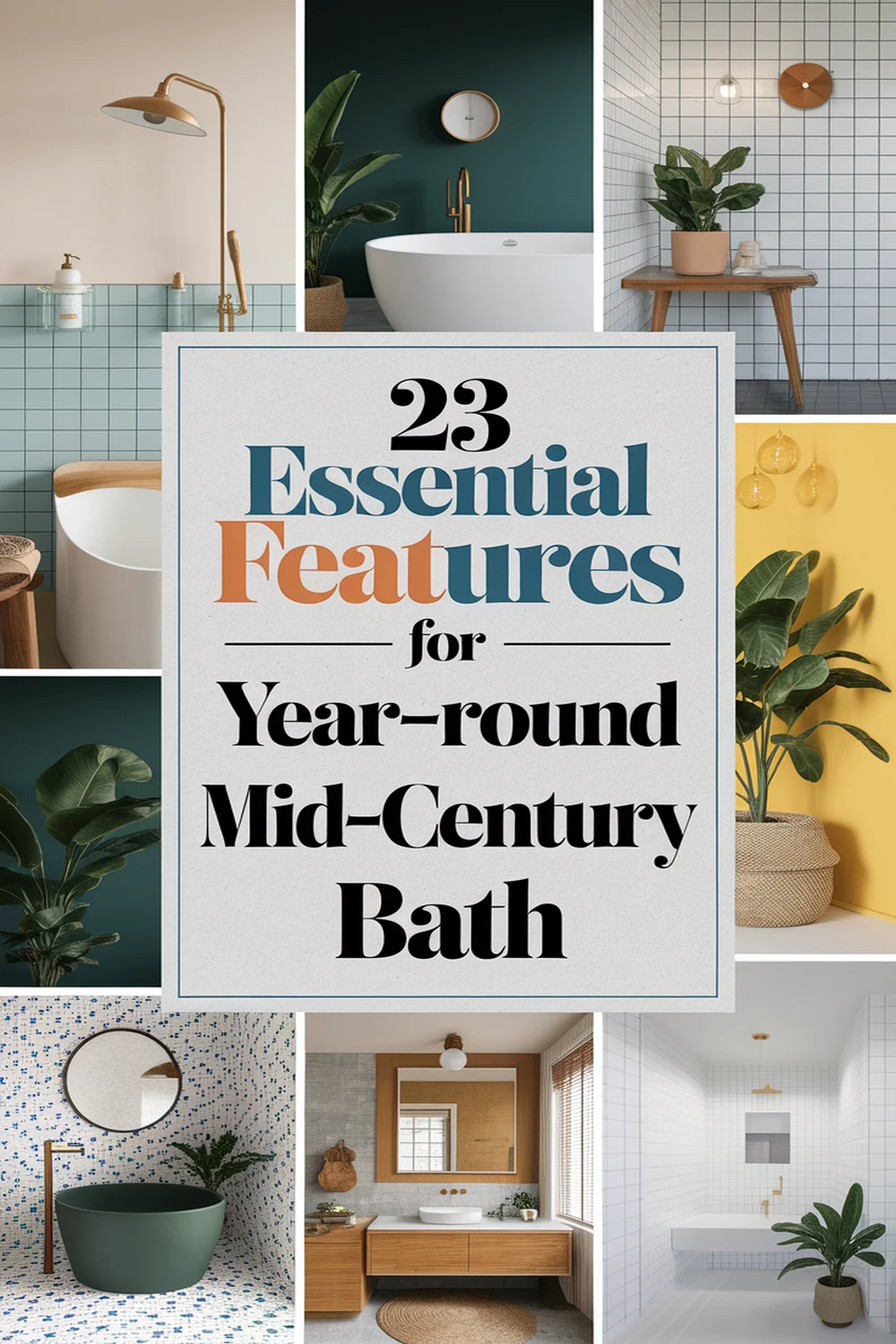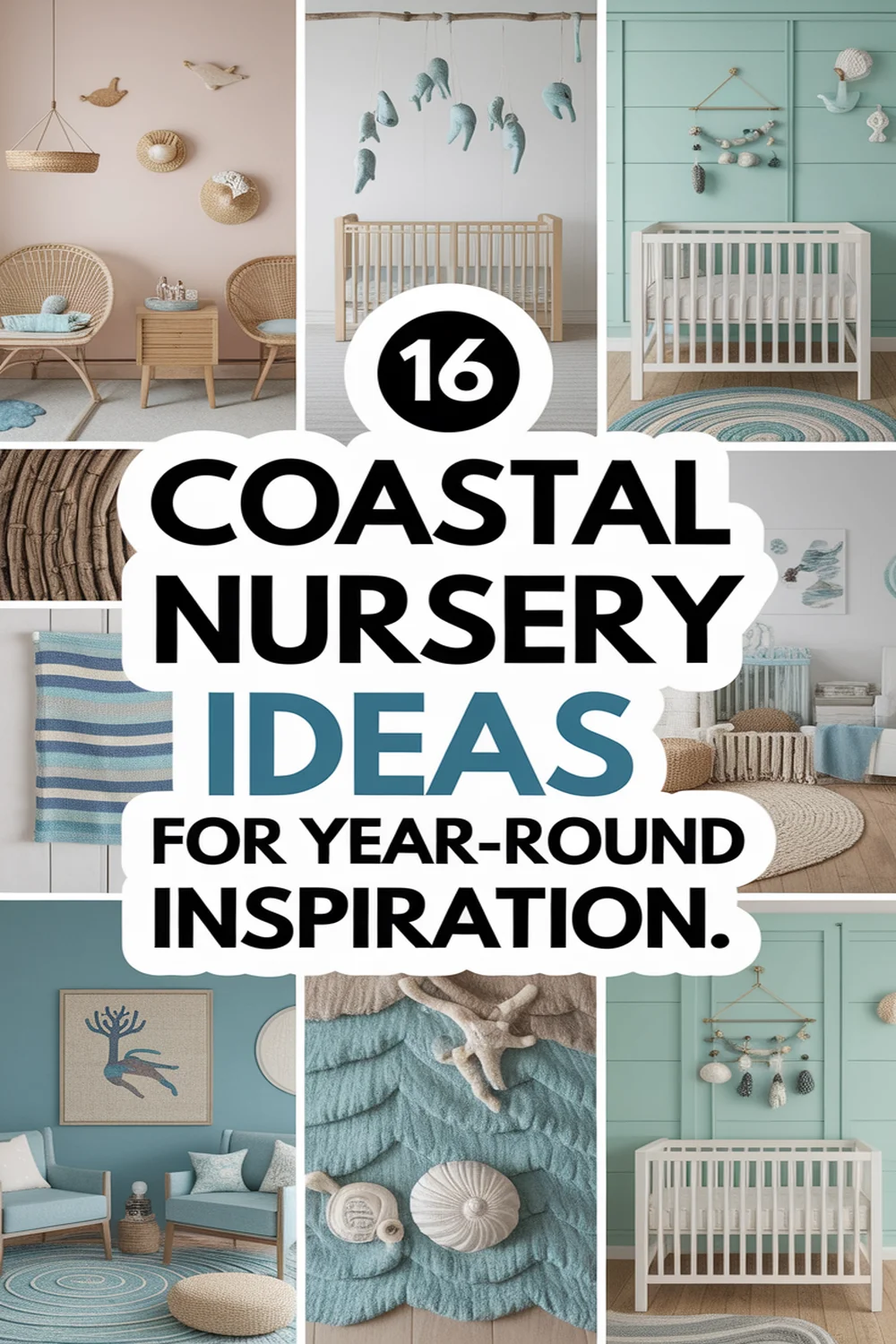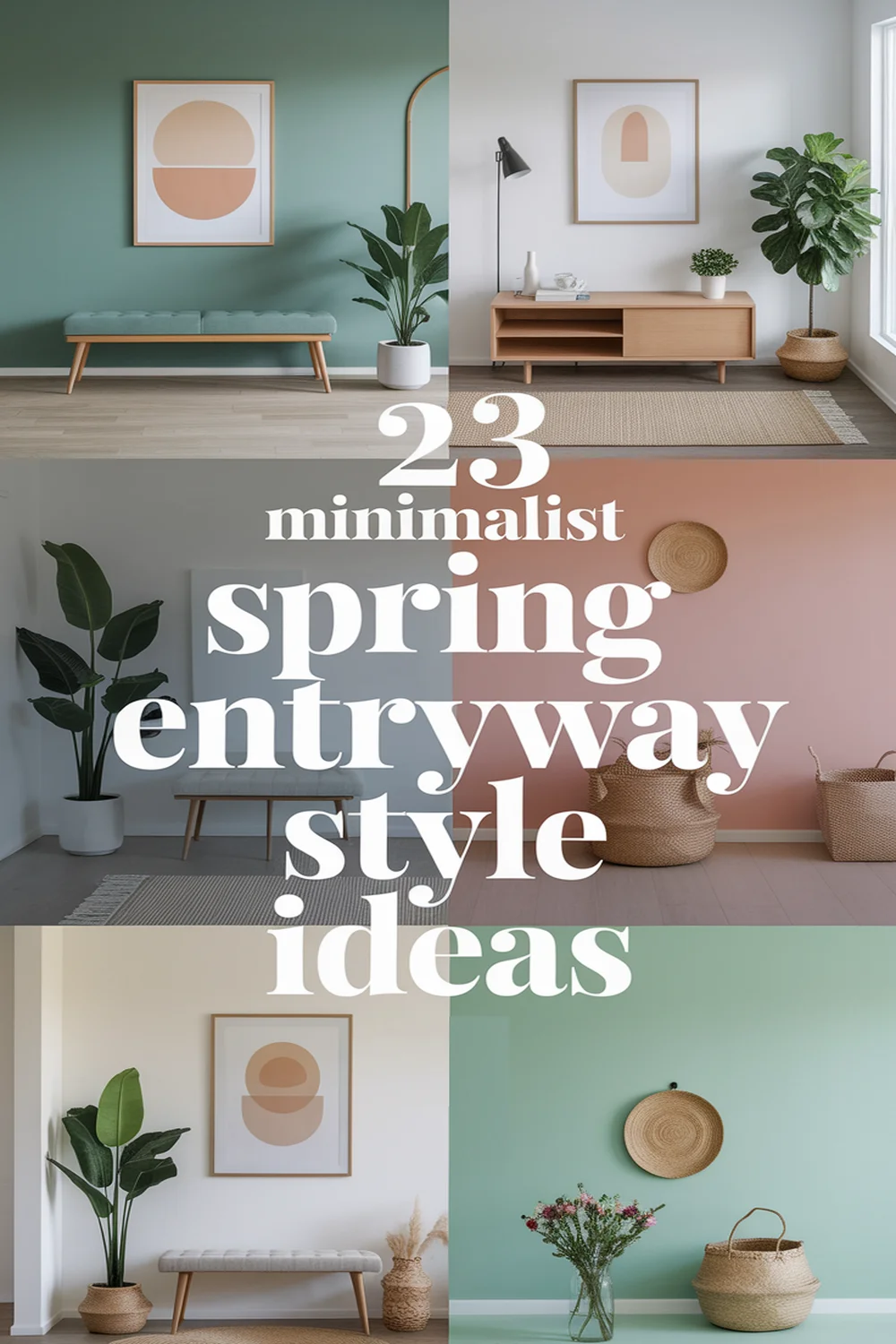This post may contain affiliate links. Please read our policy page.
A year-round library in mid-century modern style captivates with its clean lines, organic materials, and open spaces designed for community interaction. I love how abundant natural light and seamless indoor-outdoor connections create a serene atmosphere for all. This thoughtful design promotes personal wellness and fosters collaboration, making it a hub of creativity. If this piques your interest, you might find it fascinating to explore how these elements evolve to meet the needs of modern library users.
The Origins of Mid-Century Modern Design
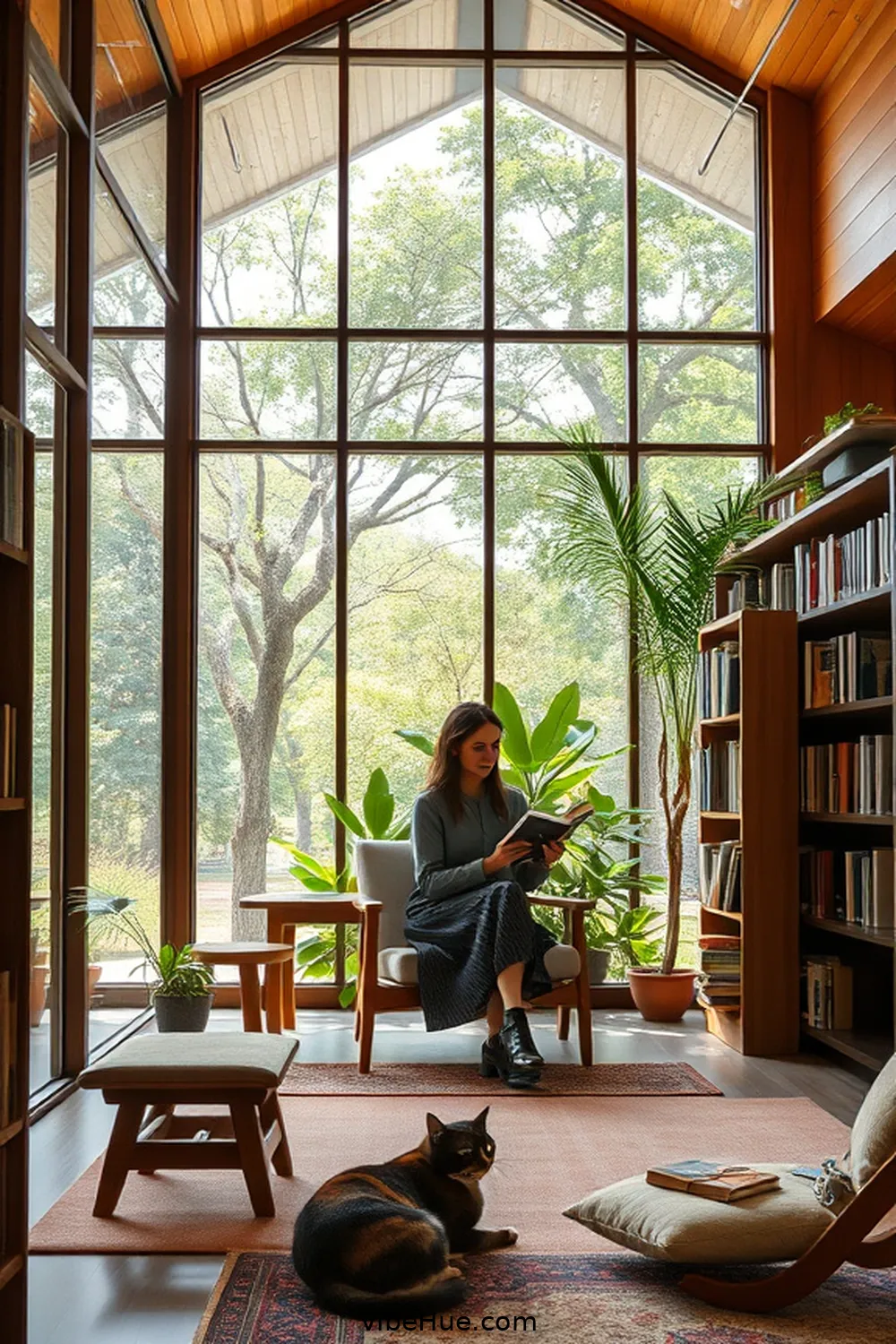
When we plunge into the origins of Mid-Century Modern design, it’s clear that this movement emerged as a response to the complexities of post-World War II society.
Amid the chaos of a rapidly changing world, designers sought simplicity and functionality, reflecting the optimism of the time. Incorporating clean lines and organic forms, this style broke away from traditional design norms, encouraging a sense of openness and connection to nature.
I find it fascinating how Mid-Century Modernism’s focus on innovation and accessibility mirrored the societal shifts towards suburban living and technological advancements.
Key Characteristics of Mid-Century Modern Libraries

As Mid-Century Modern design took shape, it found a unique expression in libraries, blending functionality with a distinct aesthetic. These libraries reflect simplicity, integrating clean lines, organic shapes, and natural materials. Large windows invite natural light, fostering a warm, inviting atmosphere.
Here’s a quick look at the characteristics:
| Characteristic | Description |
|---|---|
| Clean Lines | Minimalistic façade without excessive ornamentation. |
| Organic Materials | Use of wood, stone, and glass for a natural feel. |
| Functional Layout | Spaces designed for easy navigation and engagement. |
| Color Palette | Warm tones and earthy hues that promote comfort. |
| Integration with Nature | Flow between indoor and outdoor areas enhances serenity. |
This combination not only empowers learning but also encourages community interaction.
Emphasis on Open Spaces
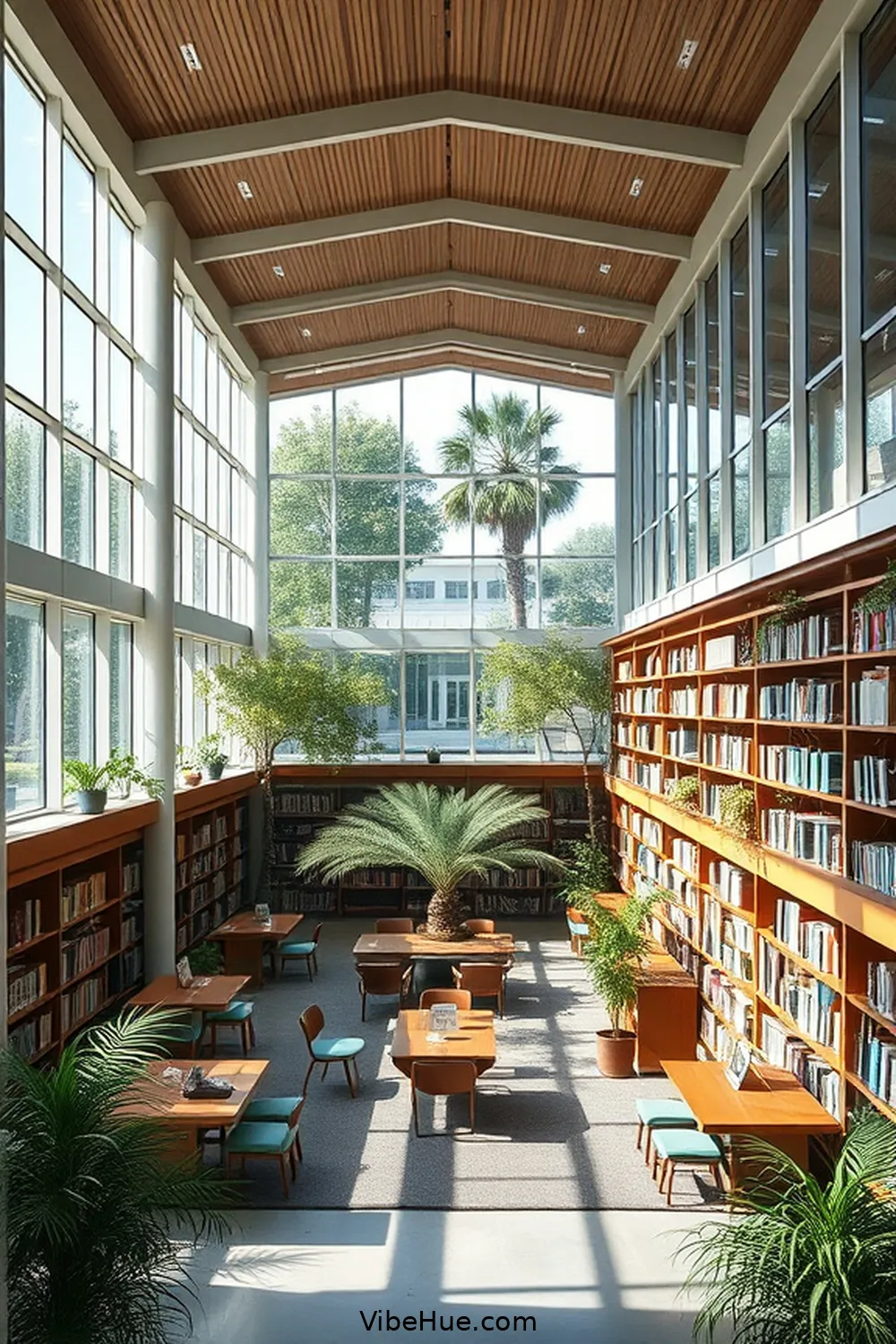
The emphasis on open spaces in Mid-Century Modern libraries creates an inviting environment that promotes collaboration and creativity. When I step into these libraries, I’m immediately struck by the expansive areas that encourage interaction among patrons.
The flexible layouts are designed to accommodate various activities—whether it’s group study, community events, or quiet reading. This openness fosters a sense of community, breaking down traditional barriers often found in more confined spaces.
The minimalist furniture invites families and individuals to engage freely, without the feeling of being cramped or isolated. By prioritizing openness, these libraries don’t just house books; they nurture ideas, allowing vibrant discussions and innovative thinking to flow naturally.
Isn’t that the heart of what a library should be?
Recommended Items
Here are our recommended products and equipment to install—feel free to explore!
Abundant Use of Natural Light

While it’s easy to overlook, the abundant use of natural light in Mid-Century Modern libraries transforms the reading experience, making it not just functional but profoundly uplifting.
Large windows and clerestory designs invite sunlight to pour in, creating a vibrant atmosphere that energizes anyone who steps inside. I find that this natural illumination enhances focus and creativity, allowing me to immerse myself in books without the harsh glare of artificial lighting.
It harmonizes with the clean lines and open spaces of the architecture, fostering a sense of tranquility and connection to the environment. This thoughtful integration of light not only elevates aesthetics but also enriches our cognitive experience, proving that a well-lit space can truly inspire.
Seamless Indoor-Outdoor Connections

Natural light flows seamlessly into the design of Mid-Century Modern libraries, creating a foundation for indoor-outdoor connections that feel organic and inviting.
These connections serve not only aesthetic purposes but also enrich the experience of every visitor. Here’s how:
- Large Glass Panels: Floor-to-ceiling windows encourage a visual dialogue between interiors and nature, enhancing the sense of space.
- Transitional Spaces: Patios or terraces become extensions of library areas, offering serene reading spots amidst greenery.
- Natural Materials: Using wood and stone inside mirrors outdoor elements, fostering a cohesive and tranquil atmosphere.
Functional Furniture and Layouts
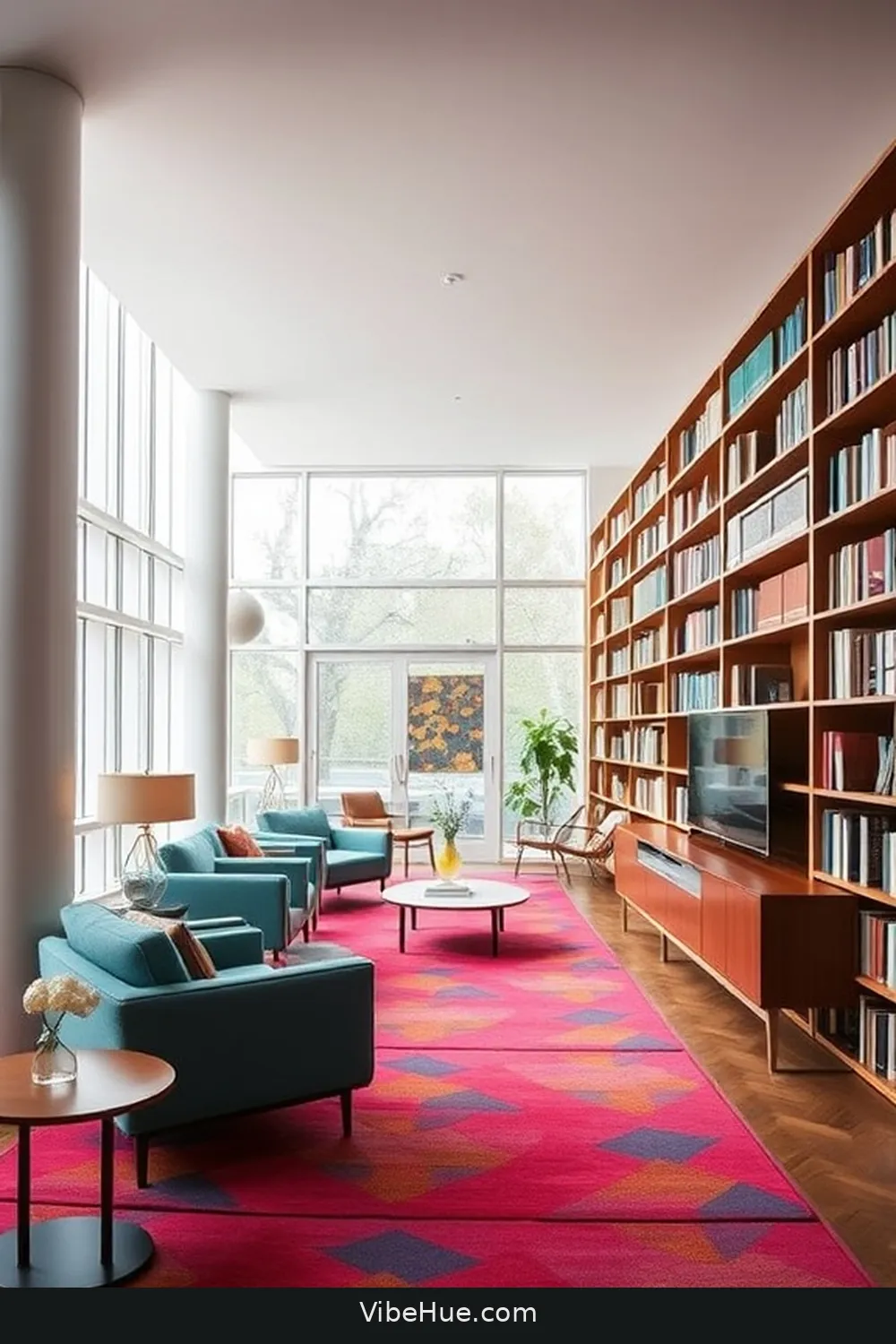
In designing a year-round library, choosing functional furniture and layouts is essential for creating versatile spaces that adapt to a variety of activities.
I’ve found that modular seating and multi-purpose tables maximize usability, allowing for group study sessions, quiet reading nooks, or community events. Open layouts can promote flow and collaboration, while strategically placed furniture can define different zones without creating barriers.
Adjustable lighting further enhances functionality, catering to both cozy reading times and larger gatherings. Thoughtfully selected furniture that embodies mid-century modern aesthetics not only serves practical needs but also evokes a sense of style.
Emphasizing functionality in layout and furniture choices transforms a library into a dynamic environment where creativity and learning flourish.
Color Palettes and Material Choices

Creating inviting spaces in a year-round library hinges on the thoughtful selection of color palettes and materials. I believe that a well-curated atmosphere greatly enhances the user experience.
Here are three key elements to take into account:
- Earthy Tones: Soft browns, muted greens, and deep blues evoke a sense of calm, encouraging visitors to relax and focus.
- Natural Materials: Incorporating wood, stone, and glass not only pays homage to mid-century design but also creates an organic feel, connecting indoor spaces with nature.
- Warm Accents: Pops of vibrant colors, like mustard yellow or teal, add life to the environment, making it welcoming without overwhelming the senses.
Through intentional color and material choices, we can create a library that inspires creativity and fosters a sense of belonging.
Community-Centric Spaces
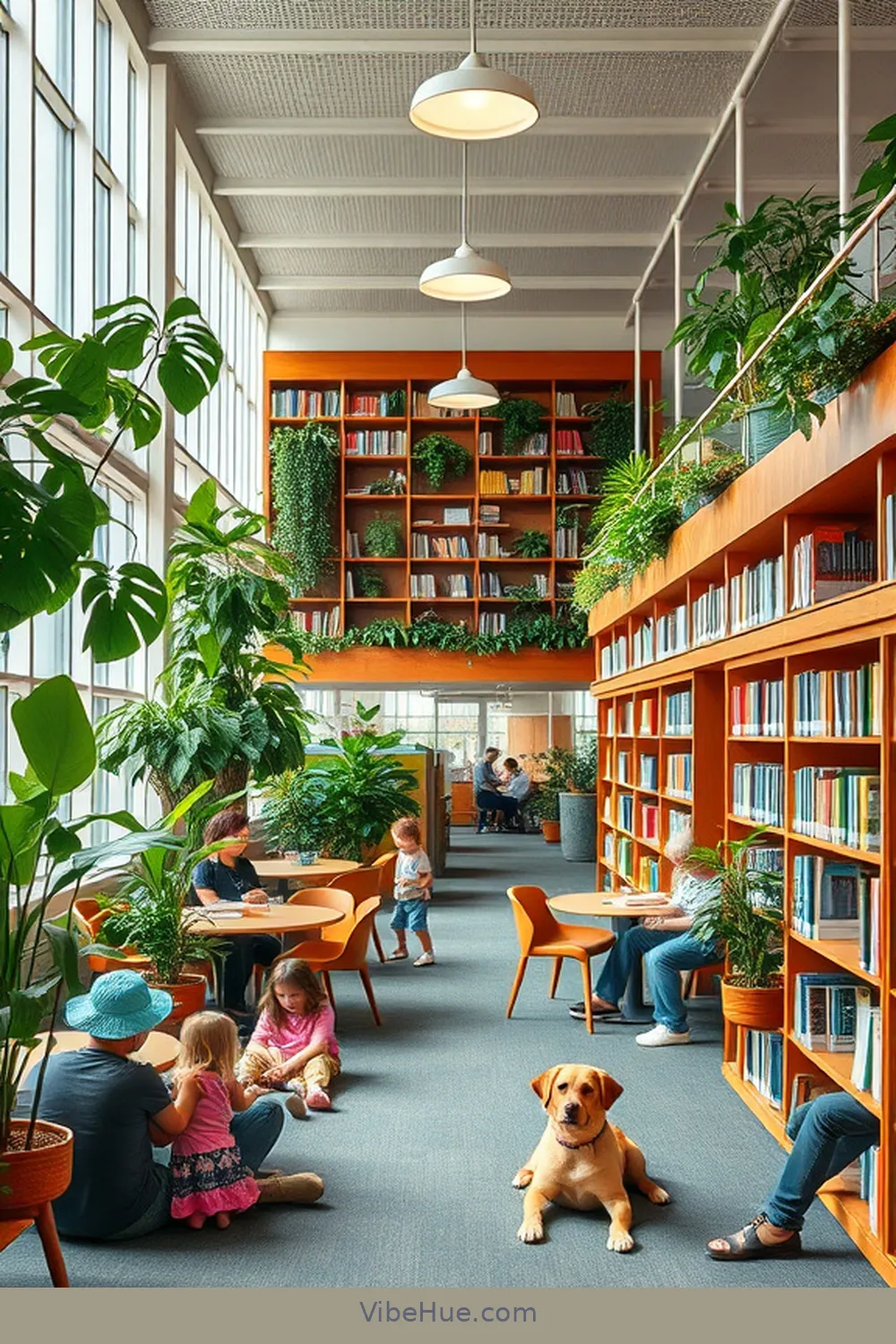
While envisioning a year-round library, I can’t help but prioritize the importance of community-centric spaces, which serve as essential hubs for connection and collaboration.
These spaces foster a sense of belonging, inviting diverse groups to gather, share ideas, and learn from one another.
Imagine cozy reading nooks that encourage quiet reflection, paired with vibrant areas for workshops and discussions.
By incorporating flexible layouts, we create environments that adapt to the needs of the community, whether it’s hosting book clubs, children’s storytime, or art exhibits.
This approach not only aligns with the Mid-Century Modern ethos of openness and light, but it also cultivates an engaged community, enriching lives through interaction and the shared love for knowledge.
Technological Integration in Mid-Century Libraries

Envisioning a year-round library not only calls for community-centric spaces but also necessitates the thoughtful integration of technology.
To create a modern library that inspires and engages, I believe we need to contemplate three key elements:
We must consider essential elements to design a library that truly inspires and engages our community.
- Digital Access Points: Stations equipped with tablets and computers allow patrons to explore digital resources and engage in virtual learning experiences.
- Smart Lighting: Utilizing energy-efficient, adaptive lighting enhances both ambiance and functionality, creating an inviting atmosphere for reading or studying.
- Interactive Displays: Implementing touch screens and informational kiosks can facilitate easy navigation, highlight events, and cultivate curiosity about available resources.
Preservation of Historical Context

Although modern libraries should embrace innovation, preserving the historical context of their surroundings is just as essential. When I walk through a library that honors its roots, I can feel the past resonate within its walls. It creates a bridge between generations, engaging visitors not just with books, but with the legacy of design and culture.
| Historical Feature | Modern Adaptation |
|---|---|
| Original Architecture | Flexible Spaces |
| Local Cultural Elements | Interactive Exhibits |
| Community Heritage | Digital Storytelling |
Step-by-Step Guide for Your Mid-Century Library
Environmental Sustainability Practices
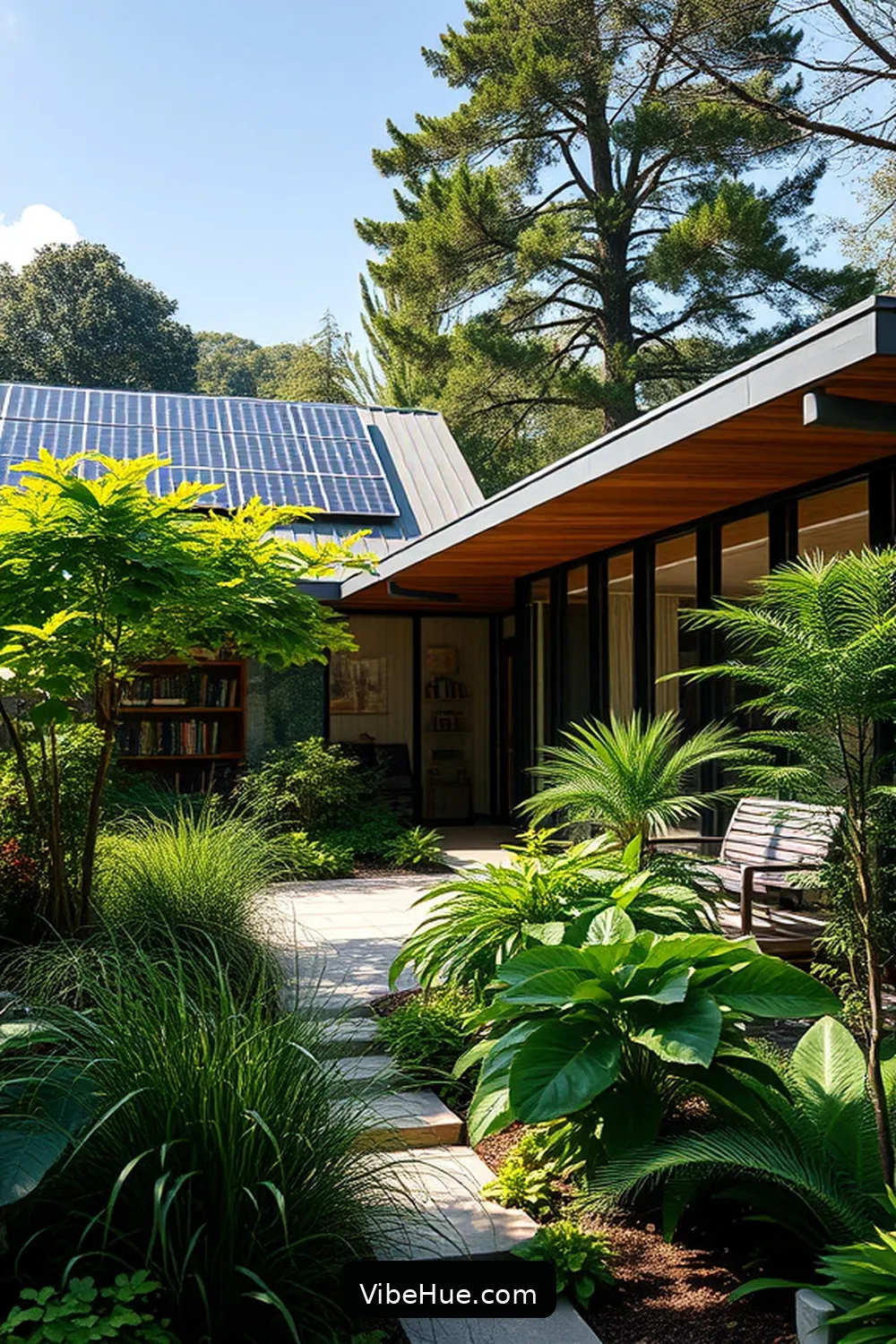
Preserving historical context isn’t just about honoring the past; it’s also about ensuring a sustainable future.
Preserving history enriches our present and shapes a sustainable future for generations to come.
As I envision this year-round library in Mid-Century Modern style, I see a commitment to environmental sustainability that attracts both patrons and nature enthusiasts.
To truly embody this ethos, we must focus on:
- Energy-efficient design: Using large windows for natural light and passive solar heating reduces energy costs.
- Sustainable materials: Sourcing locally made, renewable materials minimizes our carbon footprint.
- Green technologies: Installing rainwater harvesting systems and solar panels demonstrates leadership in environmental responsibility.
The Role of Art and Culture

As I explore the potential of this year-round library, I can’t help but recognize the profound impact art and culture have on community engagement and education. Integrating local artists‘ works into the library’s design invites visitors to connect deeply with their surroundings.
Imagine vibrant murals, thought-provoking sculptures, and interactive installations transforming each visit into a cultural experience. Hosting art workshops, theater performances, or literary readings fosters a sense of belonging and sparks creativity among patrons of all ages.
Evolving Needs of Modern Library Users
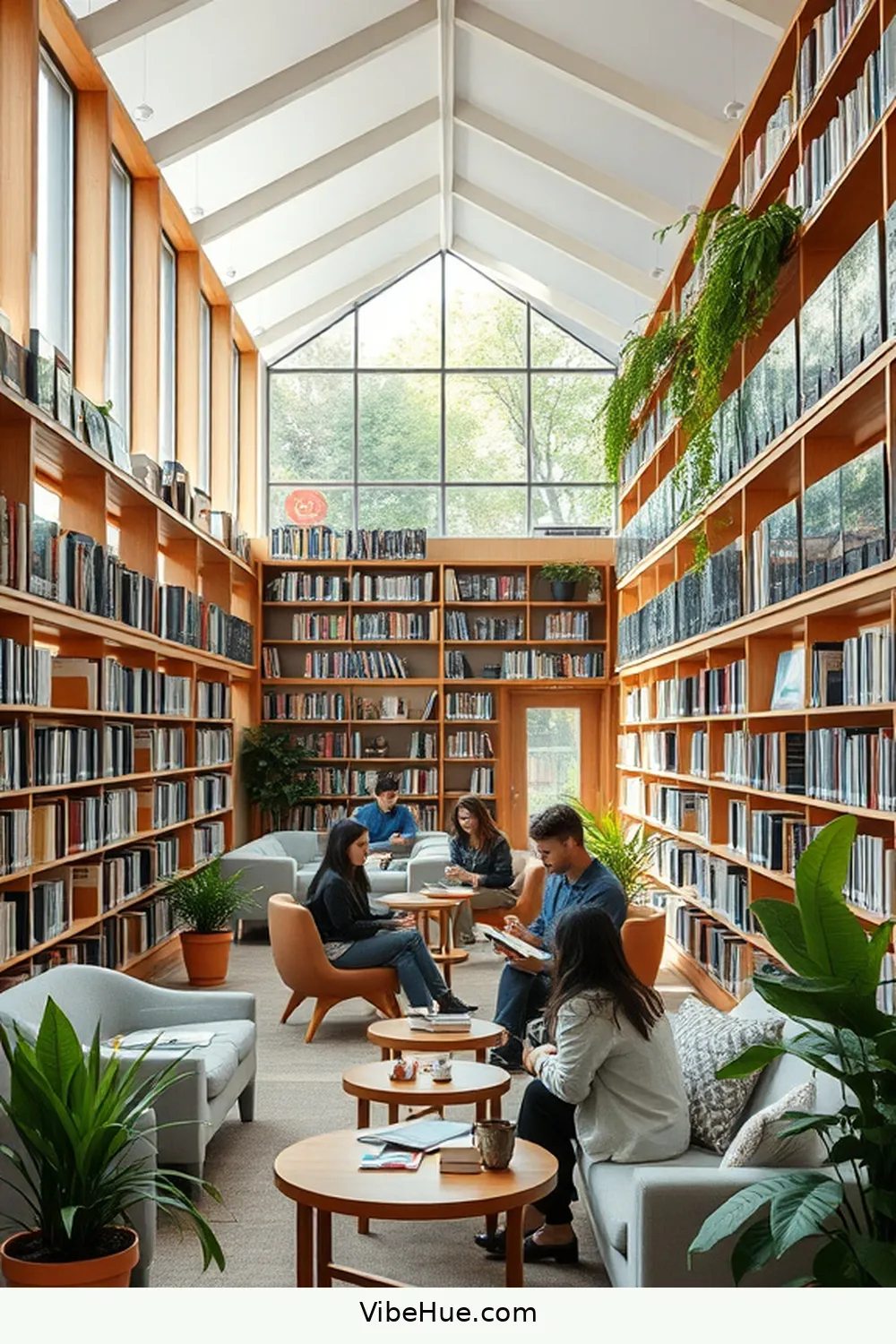
Art and culture enrich the library experience, but they also highlight how library users’ needs are changing.
As I observe these shifts, I can’t help but realize three significant needs that modern library users have:
- Collaborative Spaces: Users crave areas where they can gather, create, and share ideas, fostering a sense of community.
- Technology Access: With the digital age booming, users demand access to computers, high-speed Wi-Fi, and tech support, ensuring they stay connected and informed.
- Diverse Programs and Resources: Today’s readers seek varied programs—workshops, lectures, and cultural events—that reflect their interests and backgrounds.
Inspiring Future Library Designs
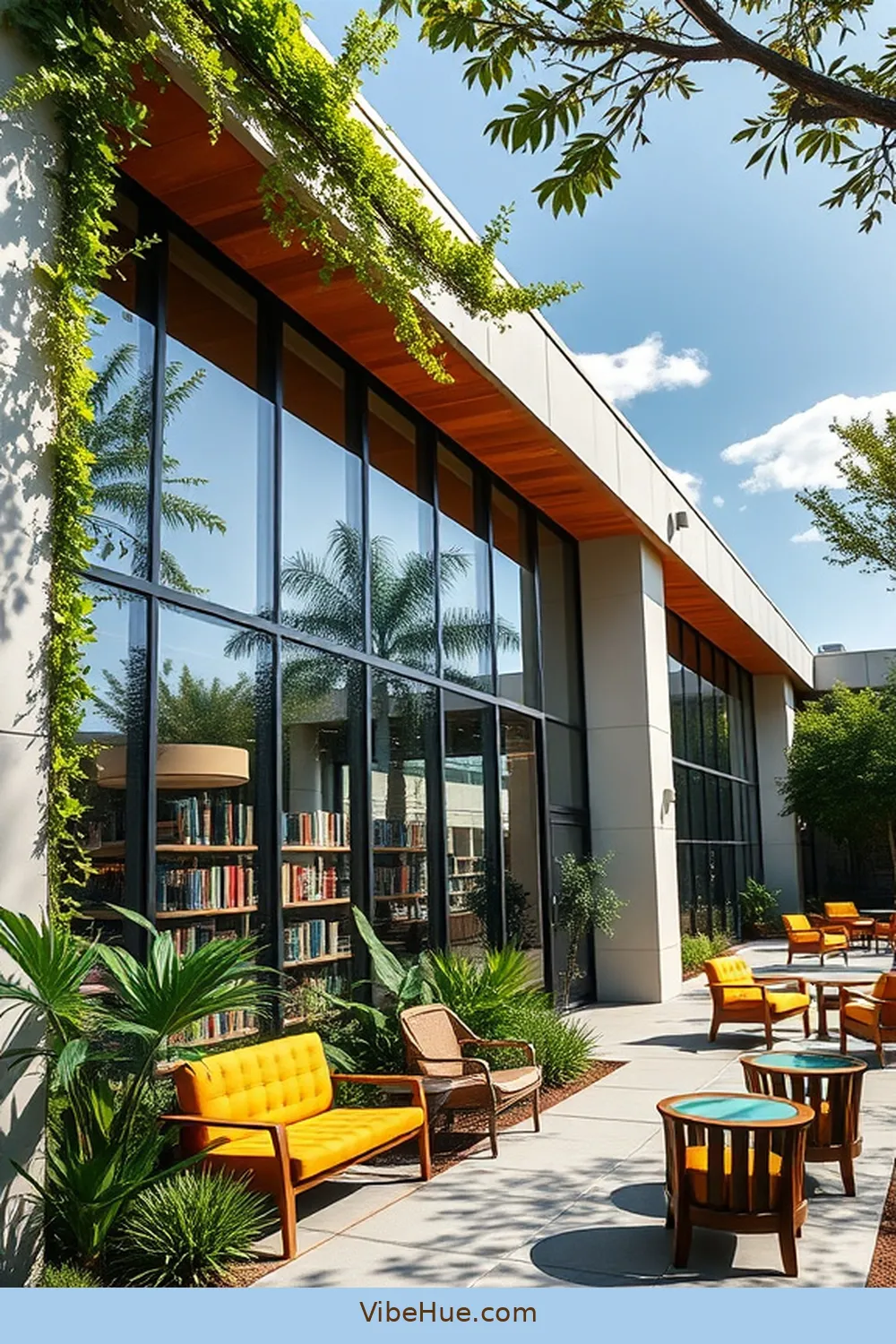
While envisioning future library designs, it’s clear that they mustn’t only reflect architectural innovation but also embody the evolving needs of their users.
Libraries should seamlessly blend technology with comfort, creating spaces where individuals can immerse themselves in literature while also accessing digital resources.
Imagine incorporating flexible spaces that cater to collaborative learning and quiet contemplation alike. Natural light and green building materials will enhance these environments, promoting wellness and creativity.
Incorporating flexible spaces with natural light fosters collaboration and contemplation, enhancing wellness and creativity in modern library design.
The design should invite community interaction, perhaps through outdoor reading areas or interactive installations.
Ultimately, as libraries evolve, they should become essential social hubs that empower diverse communities, embracing both tradition and modernity to inspire a love for knowledge.
This vision will shape libraries into vibrant, accessible sanctuaries for all.





